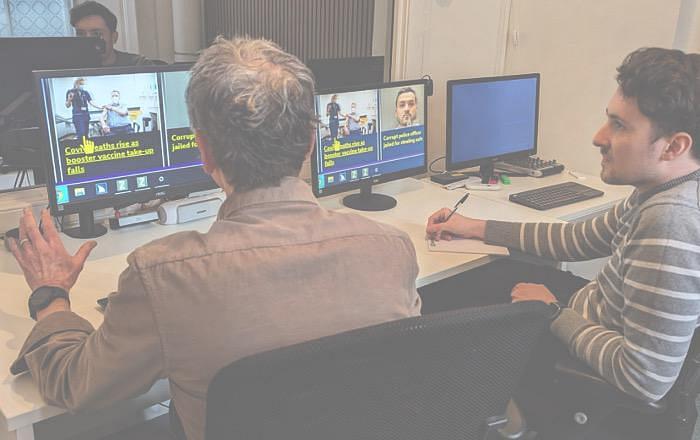The UX Toolbox - Accessibility
23 May 2018 - Ed Chandler

An Inclusive Approach to Accessibility
Accessibility is all about creating products and services that can be utilised by the widest possible audience, allowing for any impairments or differences in ability. This goes beyond ensuring that users with disabilities can use websites and apps.
Accessibility challenges can range from the subtle (e.g. colour blindness) to the significant (e.g. complete loss of sight), and from temporary (e.g. broken arm) to the permanent (e.g. loss of limb). They also impact all aspects of service delivery, not just those involving a screen. By understanding the challenges and designing in a way that includes all users, you can offer products and services to the widest possible audience, delivering commercial, legal and ethical benefits for your business.
People with disabilities represent the largest minority worldwide with a discretionary income in the billions. Companies risk losing customers, revenue and top talent while also facing legal risk, as digital accessibility is required by law in many countries.
According to estimates from the Department for Work and Pensions(this will open in a new window), over 20% of the UK population has a disability. The prevalence of disability varies by age group, with disabilities reported(this will open in a new window) for 11% of children, 23% of working-age adults, and 45% of adults over State Pension age.
Ensuring your products and services are accessible to all not only opens up this market but also ensures you fulfil your duty under the Equality Act (2010) in the UK and other international disability requirements such as the European Accessibility Act(this will open in a new window).Adopting an inclusive approach
Adopting an inclusive approach
As you create your services and products, we help take the guesswork out of accessibility. We work with business stakeholders, delivery teams, internal accessibility experts and end users to create sustainable inclusive design practices that ensure accessible products and services. Although all steps in this approach are recommended, any accessibility work will help move an organisation closer to being usable by all customers.
The steps are:
- Inclusive design strategy
- Accessibility audit and gap analysis
- User testing
- Training & development
Let’s look at these in turn.
1. Inclusive design strategy
An inclusive design strategy embeds accessibility practices into your business processes so that accessibility becomes part of a “business as usual” approach rather than a stand-alone and expensive initiative. The strategy is based on the vision guiding the inclusive design process (the “why”), the activities that need to be undertaken to deliver the vision (the “how”), and the teams that will be responsible for the delivery (the “who”).
When User Vision’s accessibility experts work with clients to develop an inclusive design strategy, we bring in stakeholders from across the organisation toundertake a series of collaborative workshops to create an effective strategy. As part of this we can evaluate your organisation’s accessibility maturity and provide recommendations to increase the governance and management of accessibility across all projects.
2. Accessibility audit and gap analysis
Accessibility audits evaluate products and services using various means, from automated accessibility tools through to manual code checks and using assistive technology such as screen readers, magnifiers and adaptive switches. Using these various methods, weidentify the issues, describe who will be affected by them and devise the best solutions. This helps organisations to achieve their accessibility goals, and comply with the W3C’s Web Content Accessibility Guidelines 2.2 and internal organisational guidelines.
Accessibility audits vary in their depth and comprehensiveness. Although several online tools exist that can automatically identify some fundamental accessibility issues, they typically can only identify about half the actual issues. To fully assess accessibility, we need to ‘get under the skin’ of the site, app or software. Finding all of the accessibility issues involves examining the underlying site or software code and using the site with assistive technologies used by disabled users. We take all of these steps for completeness and provide clear recommendations to resolve the issues found.
3. User testing
Accessibility is not just about creating accessible code, but rather ensuring that products and services are usable by all users, irrespective of any disabilities they may have. No matter how well you comply with technical guidelines, testing with people who have various disabilities always provides useful insights and ensures the site, software or mobile app is truly inclusive.

The process largely follows the same approach as usability testing, but incorporates the use of various assistive technologies. When the team at User Vision undertake accessibility testing, they draw from extensive experience and our diverse database of users to test with a variety of physical and cognitive impairments. This provides the widest possible assessment, as shown in our work for Emirates, Student Loans Company, and Sainsbury's Bank.
4. Training & development
The final part of the inclusive approach to accessibility is to ensure that teams have the knowledge and skills to create accessible products and services from the outset, rather than relying on an ongoing build > audit > test > fix cycle.
When delivering accessibility training we recognise that the responsibility sit across the organisation. We therefore offer training courses and mentoring programs aimed at various internal audiences, including managers, designers, developers and testers and UX researchers
Our range of courses includes:
- Accessibility Fundamentals
- Accessibility for developers
- Assistive Technology
- Managing Accessibility
- Creating Accessible documents
- Conducting Research with Neurodivergent Participants
- Usability Testing with Individuals with Disabilities
Keeping the focus on accessibility
Once you have developed your site with accessibility in mind, the next challenge is to ensure the high standards you put in place are maintained. With content and initiatives constantly changing, this is not a simple matter. We offer two main additional services to help you maintain the focus on accessibility over the long term.
1. Accessibility Maturity Audit
User Vision offers reviews or audits to assess how well organisations meet the new ISO standard 30071-1(this will open in a new window) on accessibility governance and the W3C Accessibility Maturity Model(this will open in a new window). These aim to embed digital accessibility and inclusive design thinking across an entire organisation. Providing a code of practice for creating accessible ICT products and services, they outline the necessary policies and procedures to integrate accessibility into organisational business as usual. They emphasise the need for long-term support and awareness of accessibility beyond technical compliance with guidelines like WCAG 2.2.
During our accessibility maturity audit process we research how accessibility is managed in your organisation through extensive interviews and surveys. We identify strengths and areas for improvement in your accessibility governance and advise on several practical areas of to enhance accessibility maturity.
2. Accreditation Programme
We offer an accessibility accreditation programme designed to help organisations demonstrate their commitment to inclusive design and accessibility compliance. Enhance your brand reputation and customer experience with a detailed compliance and accessibility statement and a recognised accreditation badge.
Upon successful completion of the accreditation process, you'll receive a badge that can be displayed on your website, signifying your commitment to accessibility and inclusive design. This badge will link to your Accessibility Compliance Statement. We also provide ongoing support and reassessment and annual re-audit to ensure your digital products maintain their accessibility compliance over time, demonstrating your continuous commitment to inclusive design.
What next?
To find out more about User Vision’s accessibility services and how we can help to embed an inclusive design strategy into your organisation, give us a call on 0131 225 0850 or drop us an email with your enquiry. One of our accessibility consultants would be glad to discuss your current challenges and suggest ways to make significant improvements to the accessibility of your website, app or software.
You might also be interested in...
When Did You Last Update Your Accessibility Statement?
11 December 2025Your accessibility statement says more about your organisation than you think. Learn why keeping it current matters for trust, compliance, and user experience—and what UK, EU, and US regulations expect.
Read the article: When Did You Last Update Your Accessibility Statement?Bridging Business Analysis and User Experience: Achieve Outstanding Digital Results
24 November 2025Discover how aligning Business Analysis and User Experience transforms digital projects - boosting efficiency, user satisfaction, and ROI for organisations seeking exceptional results in today’s competitive market.
Read the article: Bridging Business Analysis and User Experience: Achieve Outstanding Digital ResultsMaking Hospitality Welcoming for All: A Digital Accessibility Guide for Hotels
21 November 2025Hotels have long focused on physical accessibility, but true inclusion extends online. This practical guide explains how to make your hotel website accessible for all guests—meeting global WCAG and EAA standards, expanding your reach, and creating a seamless booking experience for every visitor.
Read the article: Making Hospitality Welcoming for All: A Digital Accessibility Guide for Hotels